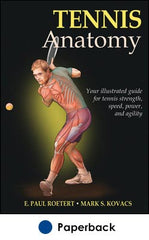Proper movement skills are vitally important for success on the tennis court.
This is an excerpt from Tennis Anatomy by Paul Roetert & Mark S. Kovacs.
Guidelines for Movement Drills
Being able to move well on the court is a huge component of successful tennis. If you can't get there, you can't hit the ball. This oversimplifies the game, but there is a lot of truth to it. We recommend you work on movement skills daily. In fact, many of the drills in this chapter can be performed with racket in hand and can even be incorporated into your on-court hitting sessions. The best way to incorporate movement drills is to make them part of each on-court practice session. They can be added at any time during practice based on your individual needs. In all movement drills, focus on proper balance, fast response time, and quick recovery. Stay light on your feet, and use good technique. If you dedicate a separate training time to movement skills, add an extra 15 to 30 minutes to work on speed and agility at the end of the tennis practice to focus on improving movement skills when you are fatigued.
Lateral Shuffle
Execution
1. Start in an athletic position, with your feet shoulder-width apart, knees slightly bent, and eyes forward. Stand at the baseline center mark with the racket in your dominant hand.
2. While maintaining a low, balanced center of mass, perform five shuffles to the left. To perform a shuffle, stay in an athletic position as you bring your feet together and move laterally without crossing the feet.
3. After five shuffles to the left, push off the outside left leg and shuffle back to the baseline center mark.
4. Repeat the movement to the right.
Muscles Involved
Primary: Adductor longus, adductor brevis, adductor magnus, gracilis, gluteus medius, iliotibial band
Secondary: Transversus abdominis, tensor fasciae latae, gluteus maximus, gluteus minimus
Tennis Focus
Lateral movement contributes to 60 to 80 percent of all tennis movements. Therefore, this movement pattern is vital for success on the court. Lateral movement is the main way players get to most groundstrokes, especially neutral balls during rallies. The abductors and adductors along with the gluteus medius help you maintain a low center of mass as you shuffle laterally to get in position to hit well-balanced groundstrokes.
Variation
Weighted Lateral Shuffle
The same movement pattern can be performed as you hold a medicine ball in front of the body at hip height. To add difficulty, extend the arms. Another variation includes wearing a weighted vest as you perform the movement. This increases the force required to perform the movement pattern.
Lateral Shuffle With Crossover
Execution
1. Start in an athletic position, with your feet shoulder-width apart, knees slightly bent, and eyes forward. Stand at the baseline center mark with the racket in your dominant hand.
2. Push off the right leg, and step the right foot over the left foot. Shuffle to the left by pushing off both feet and moving the left foot from behind the right foot and stepping to the left. Maintain a slight bend in the knees, and keep your shoulders back.
3. Repeat the movement to the right side of the baseline center mark, making sure that the first step after changing directions is a crossover step.
Muscles Involved
Primary: Adductor longus, adductor brevis, adductor magnus, gracilis, gluteus medius, iliotibial band
Secondary: Transversus abdominis, tensor fasciae latae, gluteus maximus, gluteus minimus
Tennis Focus
The lateral shuffle is the most common movement along the baseline during a rally. Often a crossover step is the first step made after a player changes directions along the baseline. It is important to replicate this movement in training with racket in hand. This movement most often occurs when a player has few time constraints and plays mostly neutral shots. The abductors and adductors along with the gluteus medius help maintain a low center of mass as you shuffle laterally to get in position to hit a well-balanced groundstroke. The speed at which players recover from wide balls typically separates the best players from the average. A faster crossover, or recovery, step allows you to get back into a successful position for your next stroke.
Variation
Weighted Lateral Shuffle With Crossover
You can perform the same movement pattern while holding a medicine ball in front of your body at hip height, or you can wear a weighted vest as you perform the movement. This increases the force required to perform the movement pattern.
Read more in Tennis Anatomy by Paul Roetert and Mark Kovacs.
More Excerpts From Tennis Anatomy

Get the latest insights with regular newsletters, plus periodic product information and special insider offers.
JOIN NOW


